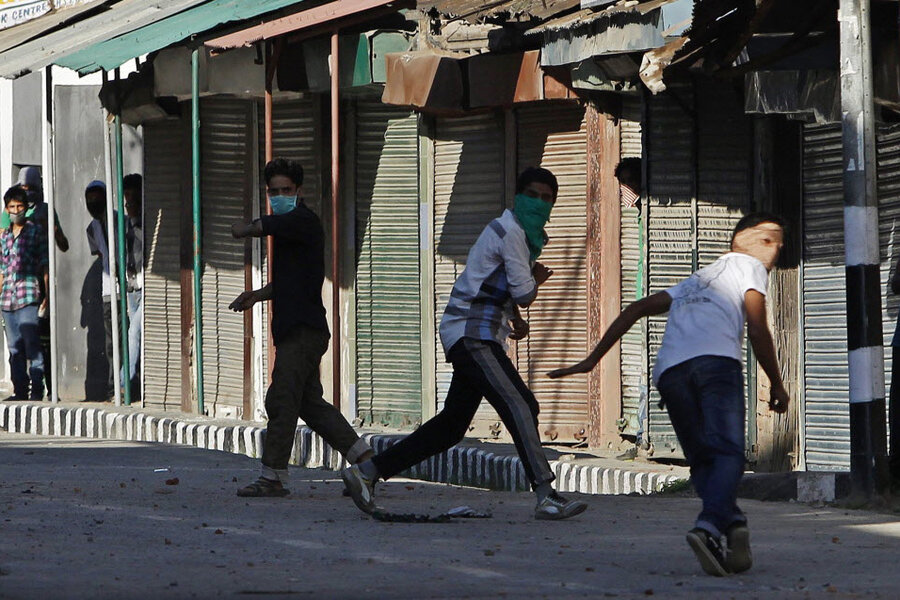India offers another investigation to calm Kashmir
| Srinagar, Indian-administered Kashmir
The Indian government has lifted a curfew and an Internet shutdown imposed to keep a lid on protests after Indian soldiers killed four unarmed civilians last week in the Ramban district of Kashmir. India has also promised to investigate the Ramban shootings in a familiar effort to calm tensions.
On Thursday, during a protest over the alleged desecration of the Quran by Indian Border Security Forces, the soldiers opened fire on civilian protesters, killing four people and injuring 48. The BSF claimed that there were "terrorists" within the crowd and that the soldiers had shot only in self-defense. As protests spread in response, the Indian government raised the compensation for the dead from $3,400 to $8,400, and assured a job to a kin of each of the slain.
India has maintained over half a million soldiers in the Himalayan region of Kashmir and grew a 100,000-strong local police force to deal with a popular rebellion that cropped up in 1990 against Indian rule. Military shootings of civilians like those in Ramban are familiar to Kashmiris – as are the Indian government's subsequent probes. Kashmiris, however, have learned to put little stock in the exercises, since they are never followed with prosecutions.
“All Indian probes in Kashmir are farcical. They are an end in itself,” says Hameeda Nayeem, a professor of English at the University of Kashmir.
Three weeks ago, two young men from Bandipore in north Kashmir were shot dead by the Indian Army. The Army later said it was "a mistake" and a similar probe was ordered.
But few are waiting to hear the result given the past pattern. According to Coalition of Civil Society, a Kashmiri human rights organization, the government has ordered 168 probes in killings by armed forces since 2002, and not a single person with the army has been prosecuted.
“The problem is the immense militarization that India has done in Kashmir with a legislated impunity given to them. All our neighborhoods, health resorts, and picnic spots have been taken over by the Indian Army, and these massacres happen all the time at one place or other and will continue to happen unless the core issues of politics and militarization are addressed,” says Professor Nayeem.
The number of militants according to both police and the Indian Army is less than 500 and has been so for the last few years, but the number of armed forces in the region has not diminished substantially.
Both India and Pakistan claim the entirety of the Kashmir region, which is split along a military line line of control that has served as a de facto border for decades. Polls in the Kashmir Valley, a Muslim-majority part of the region controlled by India, show that residents would prefer independence. New Delhi views the region, which borders Pakistan and contains the headwaters of the Indus River, as too strategic to let loose, and also worries about encouraging other separatist movements inside India's borders.
Efforts to bridge the political divide have been harmed by the scale of the past bloodshed – an estimated 70,000 Kashmiris have died since the armed uprising began in 1990 – and by India's continued use of "law and order" tactics that include repressive policing and torture.
Like the probes of human rights violations, India has announced dozens of peace processes and conflict resolution engagements with Kashmir but nothing has come of them yet. In the Valley, cynicism about India's intentions runs high given that the government's announcements of probes and processes are made when tempers are high in Kashmir and dropped when life in Kashmir returns to the routine.
After more than 120 protesters were shot dead by Indian forces during anti-India protests in 2010 that included rock throwing, an all party Indian Parliamentary delegation sent a team of "interlocutors" to access the situation in Kashmir and look for the causes of anger and the possible remedies. The report that the interlocutors submitted a year later was never discussed, surprising not so much the Kashmiris, as the interlocutors themselves.
“We had regular meetings with the Home Minister before submitting our report but once we submitted it, we never discussed it at all,” says Radha Kumar, one of the interlocutors. “Not a single member of the parliamentary committee came forward to talk about it, to see what we had written and recommended.” The Home Ministry eventually disavowed it as their own project even though they had formed and funded it.
Even the ruling party in Kashmir, the National Conference, which was the biggest proponent of a plebiscite in Kashmir for decades, passed legislation for Kashmir’s autonomy in the state assembly by a two-thirds majority but that legislation too was shelved by India.
“Our demand for autonomy was within the ambit of Indian constitution but unfortunately India is adamant on its stand that it does not care about the people of Kashmir,” says Ali Mohammad Sagar, a senior leader of the National Conference and the party’s face in Srinagar. “All their processes and probes are nonsense. They do not even trust their own interlocutors.”
Former separatist leader, Sajjad Lone, was asked to prepare a roadmap by New Delhi for a vision of Kashmir’s political future to begin an engagement. He prepared a document, Achievable Nationhood, after laboring over it for three years. It, too, was not taken up by the Indian government.
The killings that happened in Ramban earlier this week, Nayeem feels, will happen again elsewhere as long as India does not end its militarized approach to Kashmir and begins a political, goal-oriented process.






